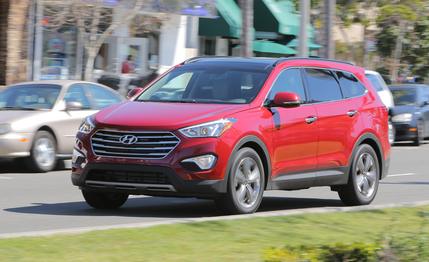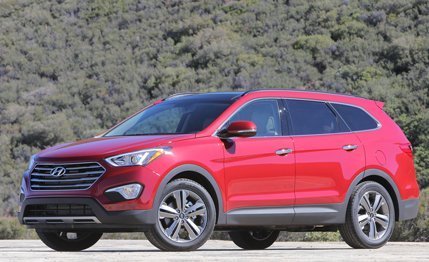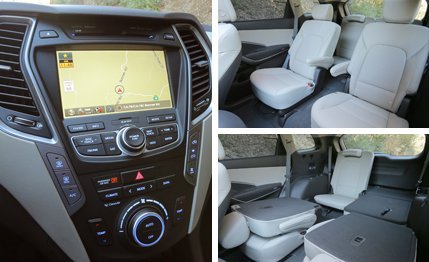 First Drive Review
First Drive Review
Okay, so “6s and 7s” is an obscure reference, but to be at 6s and 7s means to be confused and in disarray. But when it comes to its Santa Fe crossover, Hyundai is very focused—it wants to cover the bulk of the crossover market with a single nameplate. It launched this third-generation model at the 2012 New York auto show in both five-passenger Sport and six-/seven-seat long-wheelbase forms. We’ve previously reviewed both engines in the smaller Santa Fe, and just sampled the extra-large model in California.
The six-up Santa Fe comes in Limited trim and packs two captain's chair seats aft of the driver and a full-width, 50/50-split third seat out back. The third row is the same in the seven-butt GLS model, but it’s matched with a center row bench that folds in 40/20/40-percent slices (a 60/40 sliding second row is optional). The seats can lie flat in both configurations, and those with cubic-foot fetishes will find 80 of them with all seats down, 40.9 with the rearmost seats flat, and 13.5 behind the third seat when it is up.
Aside from the lack of a Sport badge, the longer Santa Fe will be easy to spot. It stretches an additional 8.5 inches from bumper to bumper than the five-seat model, and rides on a wheelbase lengthened by 3.9 inches. Another dead giveaway is the greenhouse. While the Sport’s is more dramatically pinched as it moves rearward, the bigger Santa Fe has much more glass and larger rear quarter-windows, all the better for kids stuck in the back to gaze out of. There are also minor styling changes to the front fascia.

While the Santa Fe doesn’t display any exciting stylistic elements, neither does it offend—key in this segment. It is attractive, and serves as yet another example of how far Korean automakers have come in just the past decade in terms of aesthetics. While driving a new Santa Fe we pulled up alongside a first-generation version, a decidedly ugly duckling. We're not saying the new Santa Fe is swanlike, but it easily holds its own visually against the current crossover competition.
The six- and seven-passenger Santa Fe is identical to the smaller version from the B-pillar forward, with one exception: the powertrain lineup. The Sport can be ordered with either a 2.4-liter naturally aspirated four or a 2.0-liter turbocharged four, both direct-injected. In contrast, the GLS and Limited use the 3.3-liter Lambda II V-6, also with direct injection and rated at 290 horsepower and 252 lb-ft of torque. Figure on 0-to-60-mph times of around 7.5 seconds. The EPA-estimated fuel economy is on par with that of the competition, at 18 mpg city/25 highway for front-drivers. All-wheel-drive models sacrifice 1 mpg highway. Every LWB Santa Fe has a standard trailer-prep package and can tug 5000 pounds.
Backing the V-6 is an unobtrusive six-speed automatic that can be manually controlled via the shift lever. Engine noise can intrude when the V-6 is used heavily, as on entrance ramps, but under normal operation the interior is hushed enough that you’ll hear even the quietest "Are we there yet?" from the third row, and the Santa Fe offers comfortable ride quality on all but the roughest roads. All-wheel-drive models incorporate a torque-vectoring function that brakes the inside wheel to assist cornering, but handling is purely mainstream, with some body roll, and it won’t inspire you to go boy-racer. Or even to want to toggle the electric steering between its variable-effort Sport, Comfort, and Normal settings.

Opt to carry a seventh passenger and you forego standard features such as heated side mirrors, fog lamps, automatic headlamps, front dual-zone climate control (all models have third-row HVAC controls), heated front seats, and leather upholstery. Get a Limited and you’ll have all of those goodies. Of course, GLS buyers can get all of that stuff and more by spec’ing the Popular Equipment and Leather and Premium Equipment packages. The only option for the Limited is a Technology bundle that brings a panoramic sunroof, navigation, a 12-speaker audio system, a heated steering wheel, and rear and side-window shades. Limited models get a power liftgate, while the GLS does without.
The Santa Fe is a compelling family bus, even as what it offers is pretty standard fare. But this is a segment loath to deliver surprises and one in which buyers want to receive only what they expect—and they expect their 6s and 7s to refer largely to passenger capacity.